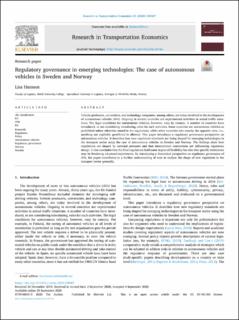Regulatory governance in emerging technologies : the case of autonomous vehicles in Sweden and Norway
Peer reviewed, Journal article
Published version

Åpne
Permanent lenke
https://hdl.handle.net/11250/3096046Utgivelsesdato
2020Metadata
Vis full innførselSamlinger
- Artikler [412]
- Publikasjoner fra Cristin [429]
Originalversjon
Research in Transportation Economics. 2020, 83 (November), 1-10. 10.1016/j.retrec.2020.100967Sammendrag
Vehicle producers, universities, and technology companies, among others, are today involved in the development of autonomous vehicles (AVs). Ongoing in several countries are experimental activities in actual traffic situations. The legal conditions for autonomous vehicles, however, vary by country. A number of countries have introduced, or are considering introducing, rules for such activities. Some countries see autonomous vehicles as prohibited unless otherwise stated in the regulations, while other countries take exactly the opposite view, i.e., anything not explicitly prohibited is allowed. This paper introduces a regulatory governance perspective on autonomous vehicles. It describes how new regulatory standards are being shaped for emerging technologies in the transport sector using the case of autonomous vehicles in Sweden and Norway. The findings show how regulations are shaped by external pressures and that international conventions are influencing regulatory design. It also concludes that the final regulations hold some degree of flexibility but also that specific restrictions may be hindering advanced experiments. By introducing a theoretical perspective on regulatory governance of AVs, the paper contributes to a further understanding of how to analyse the shape of new regulation in the transport sector generally. Keywords: regulation, policy, autonomous vehicles, regulatory governance, Norway, Sweden
